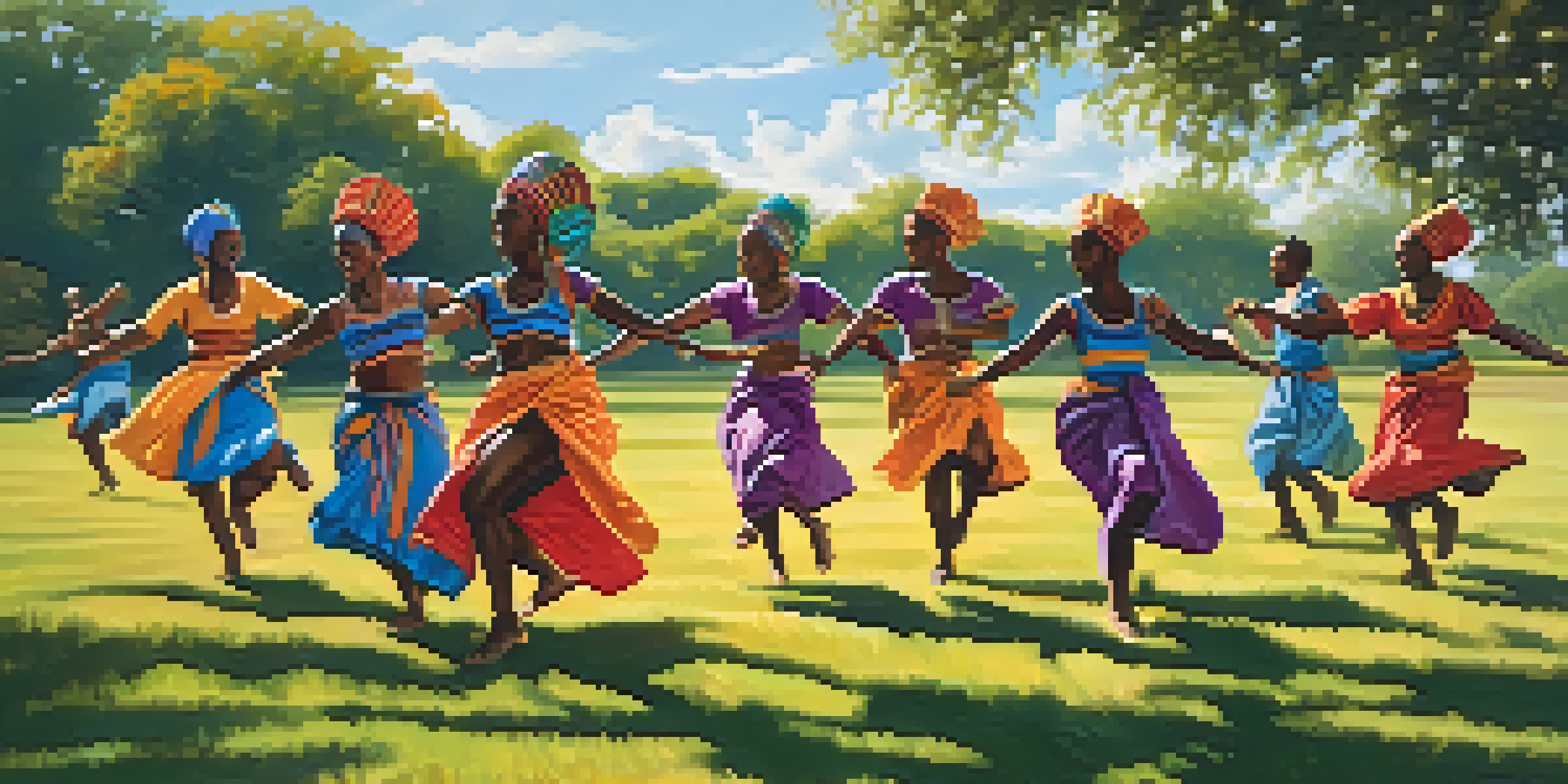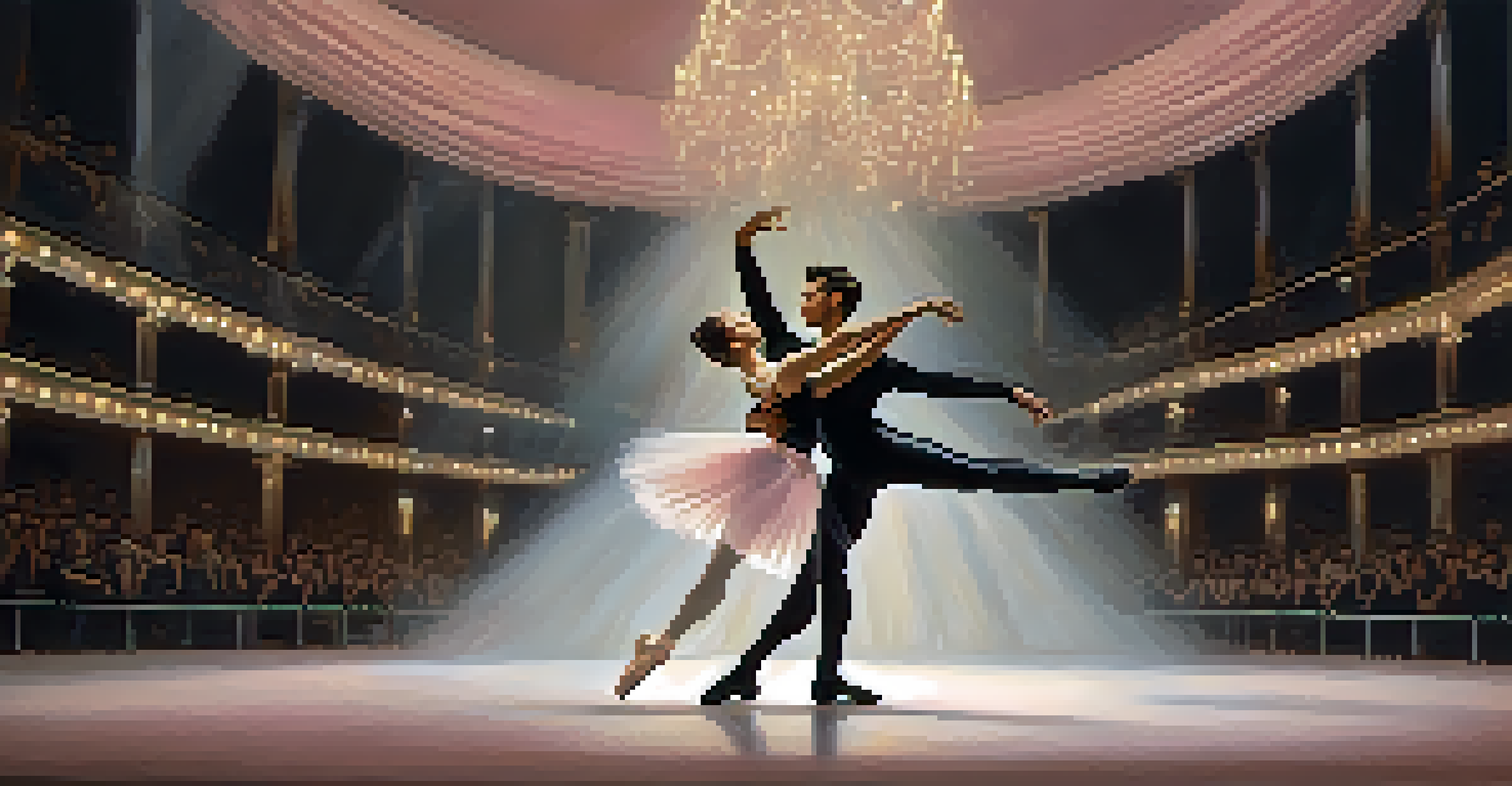Cultural Dance Forms and Their Influence on Gender Roles

Introduction to Cultural Dance Forms and Gender Roles
Cultural dance forms have long been a vibrant expression of identity, community, and storytelling. Each dance carries with it the traditions and values of its culture, and often reflects the societal norms and roles assigned to different genders. Understanding this connection can unveil how these art forms shape and are shaped by gender dynamics.
Dance is the hidden language of the soul.
In many cultures, dance is not just a form of entertainment; it's a powerful medium through which gender roles are communicated and reinforced. For instance, in some traditional dances, men may perform with strength and vigor, while women might embody grace and fluidity. These portrayals can influence how individuals perceive gender behaviors in their communities.
As we explore various cultural dance forms, we'll see how they can either challenge or reinforce existing gender roles. This examination is not only crucial for appreciating these art forms but also for understanding the broader implications they have on societal expectations and norms.
Ballet: A Reflection of Traditional Gender Roles
Ballet, often considered a pinnacle of classical dance, has historically emphasized traditional gender roles. Male dancers typically portray strength and power, while female dancers are often cast in roles that require delicacy and grace. This dichotomy reflects a broader societal view of masculinity and femininity that has persisted for centuries.

The choreography in ballet frequently highlights these roles, with men lifting and supporting women, which can symbolize protection and dominance. While this can be seen as a beautiful partnership, it also reinforces the idea that women should occupy subordinate positions. Over time, this has sparked conversations about the portrayal of gender in ballet and whether these narratives are outdated.
Dance Reflects Gender Dynamics
Cultural dance forms express and reinforce societal gender roles, showcasing the interplay between tradition and modernity.
In recent years, however, ballet has started to evolve. Contemporary choreographers are beginning to challenge traditional representations, offering more diverse portrayals of gender that break away from these long-standing norms. This shift not only enriches the art form but also invites audiences to reconsider their perceptions of gender roles.
African Dance: Celebrating Community and Gender Fluidity
African dance forms are rich with cultural significance, often celebrating community, history, and identity. Many African dances feature both men and women in roles that may blur traditional gender lines, emphasizing collaboration and unity. This inclusivity can lead to a more fluid understanding of gender within these cultures.
The body says what words cannot.
In many African communities, dance is a communal activity that invites everyone to participate, regardless of gender. This collective involvement fosters a sense of belonging and challenges the rigid gender roles often seen in Western dance forms. The storytelling aspect of these dances often showcases both male and female experiences, thereby enriching the narrative landscape.
Moreover, the rhythm and movement in African dance can express emotions and stories in ways that transcend gender. This allows individuals to connect with the dance on a personal level, encouraging a broader view of gender roles that values expression and participation over traditional binaries.
Samba: Gender Roles in Brazilian Culture
Samba, a lively and rhythmic dance from Brazil, is often associated with Carnival celebrations and cultural pride. In samba, the interaction between male and female dancers can highlight both traditional and evolving gender roles. Men's roles in samba often emphasize power and boldness, while women's roles showcase sensuality and rhythm.
However, samba also offers a platform for challenging these stereotypes. Women in samba have increasingly taken on leadership roles, both in performance and in dance schools, pushing back against the notion that they must always play supporting roles. This shift reflects a growing recognition of women's agency within Brazilian culture.
Evolving Gender Roles in Dance
Many traditional dance styles are shifting to challenge outdated gender representations, allowing for more diverse portrayals.
The vibrant nature of samba allows for a dynamic expression of identity that can evolve over time. As societal attitudes towards gender continue to change, so too does the performance of samba, creating a dance form that can both celebrate tradition and embrace modernity.
Kathak: A Dance Form Bridging Gender and Tradition
Kathak, a classical dance from North India, beautifully intertwines storytelling and intricate footwork. Traditionally, Kathak was performed by both men and women, but the roles and narratives often reflected societal gender norms. Men typically took on more heroic roles, while women expressed longing and devotion.
Despite these traditional roles, Kathak has become a canvas for exploring complex gender dynamics. Contemporary practitioners are reinterpreting classical stories, allowing women to portray strength and agency rather than solely passive figures. This evolution highlights the dance's adaptability and relevance in modern society.
The combination of storytelling and movement in Kathak creates a rich tapestry for discussing gender roles. By reimagining these narratives, dancers are not only preserving their cultural heritage but also opening up conversations about gender equality and representation in the performing arts.
Flamenco: Passion and Gender Dynamics in Spanish Culture
Flamenco, with its passionate movements and vibrant music, is deeply rooted in Spanish culture, particularly in the Andalusian region. Traditionally, flamenco has showcased distinct gender roles, with male dancers often embodying strength and bravado, while female dancers express their emotions through grace and intensity. This dynamic can reinforce traditional perceptions of masculinity and femininity.
However, flamenco is also evolving, with many contemporary dancers and choreographers challenging these established norms. Women are increasingly taking on powerful roles, both as performers and choreographers, allowing for a more nuanced portrayal of gender. This shift is reshaping the narrative around flamenco and expanding its expressive possibilities.
Global Influence on Gender Perspectives
As cultural dances spread worldwide, they spark dialogue about gender equality and representation, influencing societal beliefs.
The emotive nature of flamenco allows for a deep exploration of personal and cultural identity, which can transcend traditional gender roles. As the art form evolves, it invites audiences to reconsider their understanding of gender in performance, making flamenco a powerful vehicle for social change.
The Global Influence of Cultural Dance on Gender Perspectives
Cultural dance forms from around the world share a common thread: they reflect and influence societal beliefs about gender roles. As these dances gain popularity in global contexts, they bring with them the gender dynamics inherent in their cultures. This cross-cultural exchange can lead to the reinforcement of stereotypes or, conversely, to the challenging of traditional norms.
For instance, as traditional dances are performed in international festivals, they may be interpreted through a modern lens, allowing audiences to engage with and question existing gender roles. This dialogue can stimulate new conversations about equality, representation, and the power of dance as a form of activism.

Ultimately, cultural dance serves as a mirror, reflecting not only the customs and values of a society but also the evolving understanding of gender. By appreciating and embracing this art form, we can contribute to a more inclusive and equitable dialogue about gender across cultures.